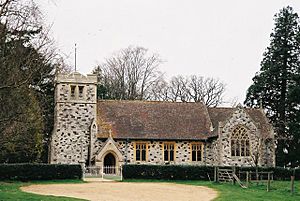St Stephen's Church, Pamphill facts for kids
St Stephen's Church is a special church located in Pamphill, a village in Dorset, England. This church stands on the same spot where an even older church was built way back in 1229. The current building was planned in 1846, but it took a long time to finish. It was finally completed in 1907, designed by a builder named C. E. Ponting. St Stephen's is also known as the family church for the important Bankes family of Dorset.
Contents
A Look at the Church's History
The First Church (1236-1573)
Long ago, in 1230, a powerful man named John de Lacy was given the land of Kingston Lacy. He was one of the twenty-five barons who helped make sure the Magna Carta (a very important document from 1215) was followed. John de Lacy decided to build a new church for one of the villages he owned. After seven years of building, a church dedicated to St Stephen was finished in 1236. This first church lasted for many years, but by 1573, it had fallen apart so much that it could not be fixed and was left abandoned.
Building the Current Church (1907)
The church you see today was built thanks to money left by Walter Ralph Bankes. It is located on the beautiful grounds of Kingston Lacy House, which is now looked after by the National Trust. The church was finally completed in 1907 as a way to remember Walter Ralph Bankes. His wife, Henrietta Bankes, and his son, Sir Walter Ralph Bankes the second, were in charge of building it.
Church Design and Special Features
Architecture Style and Materials
St Stephen's Church is a great example of the Arts and Crafts style mixed with Gothic architecture. It has a tall tower that reaches about forty feet high! The walls are made from a mix of two types of stone: Studland sandstone and Purbeck Stone.
Next to the tower, above the left side of the entrance porch, there's a special spot called a niche. Inside this niche is a statue of St Stephen. He has his hand on the head of a small boy. This boy was modeled to look like Ralph, who was Mrs. Henrietta Bankes' son.
Inside the Church: Woodwork and Art
Inside the church, you'll find a beautiful font made of alabaster, which is a smooth, white stone. It is held up by four carved angels. When this font first arrived, it had a crack, so it was sent back and replaced with the perfect one you see today.
One of the most impressive things inside is the amazing woodwork. All the wood, including the pews (the long benches where people sit), is made from oak trees grown right on the Kingston Lacy Estate. Each end of the pews is carved with a special symbol called a fleur-de-lys, which was a symbol of the Bankes family. The choir stalls, where the choir sits, are also beautifully carved.
The sparkling tiled reredos (a decorated screen behind the altar) was made by Carters of Poole. They used a special "battered brass" to create the golden wings of angels and shiny mother-of-pearl for their halos. On either side of the reredos, you can see Sanctus angels carved directly into the stone.
Stained Glass Windows
The large window at the east end of the church shows Ralph Bankes sitting on Christ's lap, with his sisters, Viola and Daphne, watching. To the right of this, there are more panels showing scenes like Mary and Martha, the Good Shepherd, and the Calming of the Storm.
The west window, located at the back of the church, shows the historical symbols of the Bankes family, including the fleur-de-lys and symbols from the families their brides came from. This window was actually in Wimborne Minster before St Stephen's Church was built.
Other Important Features
You'll also find a small organ by the Positive Organ Co. Right below the organ, there's a wooden panel that lists the names of sixteen men who did not return from the First World War. This memorial was first shown on April 2, 1921.
The eight pews belonging to the Bankes family are at the very back of the church. Above these pews, there is a copy of the famous astronomical clock from nearby Wimborne Minster. Most members of the Bankes family are buried in Wimborne Minster.
Becoming Its Own Parish
Before St Stephen's Church was built, people from Cowgrove and Pamphill had to travel to Wimborne Minster for church services. At first, the new church was still part of the Wimborne Minster parish. But in 1922, thanks to Mrs. Bankes' hard work and a donation of £6,000, St Stephen's finally became its own parish with its own vicar. The grassy area around the church is not used for burials. The stone cross in front of the church is a memorial to Walter Bankes, Mrs. Bankes' husband.


